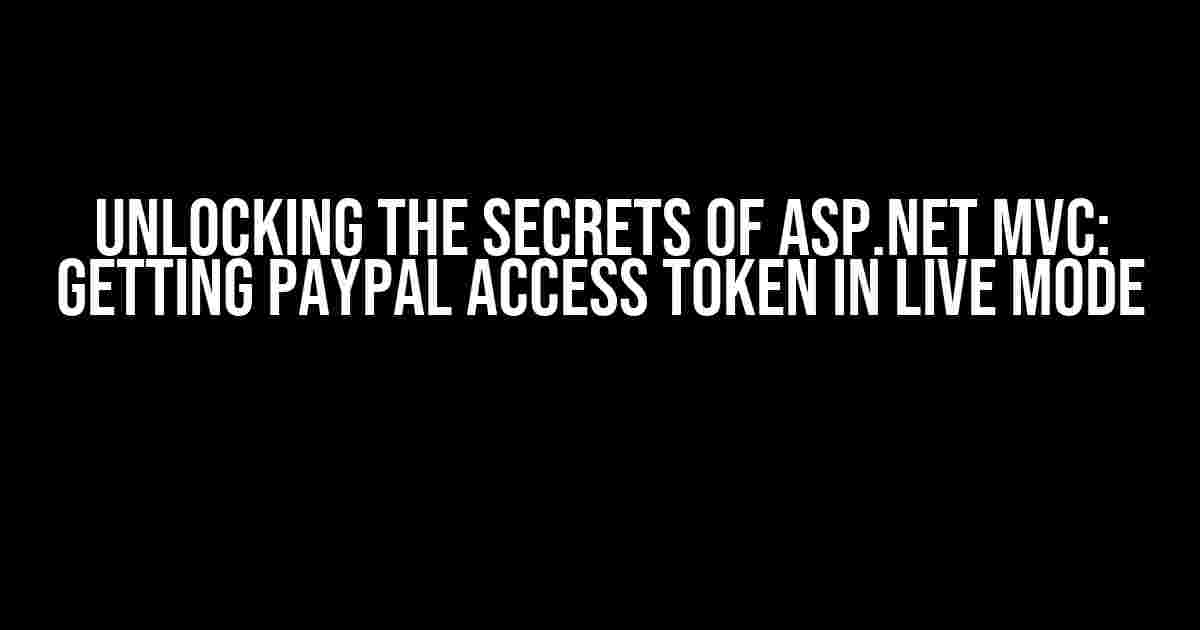Are you tired of struggling to integrate PayPal with your Asp.net MVC application? Do you find yourself stuck in the never-ending loop of errors and frustrations? Worry no more! In this comprehensive guide, we’ll walk you through the step-by-step process of getting a PayPal access token in live mode using Asp.net MVC. Buckle up, because we’re about to dive into the world of PayPal integration!
Prerequisites: Setting Up Your PayPal Account
Before we dive into the coding part, make sure you have the following prerequisites in place:
- A PayPal business account (live mode requires a verified business account)
- A PayPal developer account (create a new account if you don’t already have one)
- A PayPal client ID and secret (we’ll get to these in a bit)
Getting Your Client ID and Secret
Log in to your PayPal developer account and navigate to the My Apps & Credentials page. Click on “Create App” and fill in the required details. You’ll receive a client ID and secret, which we’ll use later in our code.
Client ID: AQkPFj7...' Secret: EHv2dFKxC...'
Setting Up Your Asp.net MVC Project
Create a new Asp.net MVC project in Visual Studio (or your preferred IDE). We’ll use .NET Core 3.1 for this example.
Install the PayPal NuGet package:
Install-Package PayPal
Adding PayPal Configuration
In your project, create a new class called PayPalConfiguration:
public class PayPalConfiguration
{
public string ClientId { get; set; }
public string ClientSecret { get; set; }
public string SandboxApiUrl { get; set; }
public string LiveApiUrl { get; set; }
public string TokenUrl { get; set; }
}
In your Startup.cs, add the following code to configure PayPal:
public void ConfigureServices(IServiceCollection services)
{
services.Configure<PayPalConfiguration>(Configuration.GetSection("PayPal"));
// ...
}
public void Configure(IApplicationBuilder app, IWebHostEnvironment env)
{
// ...
app.UseRouting();
app.UseEndpoints(endpoints =>
{
endpoints.MapControllers();
});
}
Getting the Access Token in Live Mode
Now that we have our configuration in place, let’s get the access token in live mode. Create a new controller called PayPalController:
[ApiController]
[Route("api/[controller]")]
public class PayPalController : ControllerBase
{
private readonly PayPalConfiguration _payPalConfig;
public PayPalController(IOptions<PayPalConfiguration> payPalConfig)
{
_payPalConfig = payPalConfig.Value;
}
[HttpGet]
public async Task<string> GetLiveAccessToken()
{
using (var client = new HttpClient())
{
var clientId = _payPalConfig.ClientId;
var clientSecret = _payPalConfig.ClientSecret;
var tokenUrl = _payPalConfig.TokenUrl;
var credentials = Convert.ToBase64String(Encoding.ASCII.GetBytes($"{clientId}:{clientSecret}"));
client.DefaultRequestHeaders.Authorization = new AuthenticationHeaderValue("Basic", credentials);
var request = new HttpRequestMessage(HttpMethod.Post, tokenUrl)
{
Content = new StringContent("grant_type=client_credentials", Encoding.UTF8, "application/x-www-form-urlencoded")
};
var response = await client.SendAsync(request);
response.EnsureSuccessStatusCode();
var responseBody = await response.Content.ReadAsStringAsync();
var tokenResponse = JsonConvert.DeserializeObject<PayPalTokenResponse>(responseBody);
return tokenResponse.AccessToken;
}
}
}
public class PayPalTokenResponse
{
[JsonProperty("access_token")]
public string AccessToken { get; set; }
[JsonProperty("token_type")]
public string TokenType { get; set; }
[JsonProperty("expires_in")]
public int ExpiresIn { get; set; }
}
In the above code, we’re using the HttpClient to send a POST request to the PayPal token URL with our client ID and secret. We’re then deserializing the response into a PayPalTokenResponse object and returning the access token.
Using the Access Token
Now that we have the access token, we can use it to make API calls to PayPal. Let’s create a new method in our PayPalController to get the user’s profile information:
[HttpGet]
public async Task<PayPalUserProfile> GetUserProfile(string accessToken)
{
using (var client = new HttpClient())
{
var apiUrl = _payPalConfig.LiveApiUrl + "/v1/identity/oauth2/userinfo";
client.DefaultRequestHeaders.Authorization = new AuthenticationHeaderValue("Bearer", accessToken);
var response = await client.GetAsync(apiUrl);
response.EnsureSuccessStatusCode();
var responseBody = await response.Content.ReadAsStringAsync();
var userProfile = JsonConvert.DeserializeObject<PayPalUserProfile>(responseBody);
return userProfile;
}
}
public class PayPalUserProfile
{
[JsonProperty("name")]
public PayPalUserName Name { get; set; }
[JsonProperty("email")]
public string Email { get; set; }
// ...
}
public class PayPalUserName
{
[JsonProperty("given_name")]
public string GIVEN_NAME { get; set; }
[JsonProperty("family_name")]
public string FAMILY_NAME { get; set; }
// ...
}
In this example, we’re using the access token to make a GET request to the PayPal userinfo API. We’re then deserializing the response into a PayPalUserProfile object and returning the user’s profile information.
Conclusion
And that’s it! You now have a working Asp.net MVC application that retrieves a PayPal access token in live mode. Remember to replace the placeholders with your actual PayPal client ID and secret.
In this article, we’ve covered the prerequisites for setting up a PayPal business account, creating a PayPal developer account, and getting a client ID and secret. We’ve also set up an Asp.net MVC project, configured PayPal, and retrieved an access token in live mode.
With this knowledge, you can now integrate PayPal with your Asp.net MVC application and start processing payments in live mode. Happy coding!
| PayPal API Endpoint | Description |
|---|---|
| /v1/identity/oauth2/token | Get an access token |
| /v1/identity/oauth2/userinfo | Get user profile information |
- Make sure to handle errors and exceptions properly in your production code.
- Use a secure way to store your PayPal client ID and secret (e.g., environment variables or a secure storage).
- Test your application thoroughly in sandbox mode before moving to live mode.
Frequently Asked Question
Get ready to tackle the most pressing questions about getting PayPal access tokens in live mode with ASP.NET MVC!
What is the main requirement to get a PayPal access token in live mode?
To get a PayPal access token in live mode, you need to have a PayPal business account and a verified PayPal developer account. You also need to create a REST API app on the PayPal developer dashboard and set up the necessary credentials, such as the client ID and secret.
How do I redirect users to the PayPal authorization URL in ASP.NET MVC?
To redirect users to the PayPal authorization URL, you can use the `Redirect` method in ASP.NET MVC and pass the authorization URL as a parameter. For example, `return Redirect(“https://www.paypal.com/cgi-bin/webscr?cmd=_approve_access_token&protocol=openidconnect&oauth_token=” + token);`.
What is the purpose of the `authorization_code` grant type in PayPal?
The `authorization_code` grant type is used to obtain an access token in exchange for an authorization code, which is received after the user grants permission to your app. This grant type is used in the authorization code flow, which is the recommended flow for server-side applications like ASP.NET MVC.
How do I handle errors when getting an access token from PayPal in live mode?
When getting an access token from PayPal in live mode, you should handle errors by catching exceptions and checking the error responses from PayPal. You can also use PayPal’s error codes and messages to provide more informative error messages to your users.
What is the recommended way to store the PayPal access token in ASP.NET MVC?
The recommended way to store the PayPal access token in ASP.NET MVC is to use a secure storage mechanism, such as the `Microsoft.Extensions.Configuration` library or a secure token store like Azure Key Vault. You should never store the access token in plain text or in an insecure manner.



